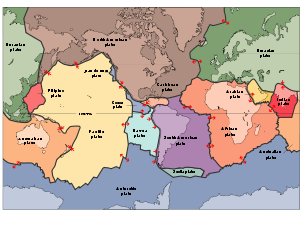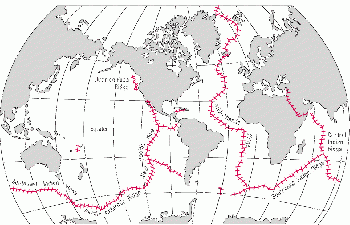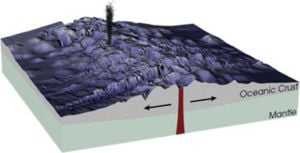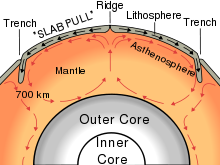Mid-ocean ridge
A mid-ocean ridge (or mid-oceanic ridge) is an underwater mountain range, typically having a valley known as a rift running along its axis, formed by plate tectonics. This type of oceanic ridge is characteristic of what is known as an oceanic spreading center. The uplifted seafloor results from convection currents that rise in the mantle as magma at a linear weakness in the oceanic crust and emerge as lava, creating new crust upon cooling. A mid-ocean ridge demarcates the boundary between two tectonic plates, and is therefore called a divergent plate boundary.
The mid-ocean ridges of the world are connected and form a single global mid-oceanic ridge system that is part of every ocean. Consequently, the mid-oceanic ridge system forms the longest mountain range in the world. According to estimates, about 20 volcanic eruptions occur along Earth's mid-ocean ridges each year, leading to the formation of 2.5 square kilometers of new seafloor. In this manner, the Earth's oceanic crust is continually renewed at the mid-ocean ridges.
Discovery
Because a mid-ocean ridge is submerged at very deep depths in the ocean, its existence was not even known until the 1950s, when it was discovered through surveys of the ocean floor conducted by research ships.
More specifically, the Vema, a ship of the Lamont-Doherty Geological Observatory of Columbia University, traversed the Atlantic Ocean and recorded data about the ocean floor from the ocean surface. A team lead by Marie Tharp and Bruce Heezen analyzed the data and concluded that there was an enormous mountain chain running along the middle of the Atlantic. The mountain range was named the Mid-Atlantic Ridge, and it remains the most famous part of the mid-ocean ridge.
At first, it was thought to be a phenomenon specific to the Atlantic Ocean, because nothing like such a massively long undersea mountain chain had ever been discovered before. However, as surveys of the ocean floor continued to be conducted around the world, it was discovered that every ocean contains parts of the ridge.
It is only in the Atlantic that the ridge system is in the center of the ocean. Nonetheless, the system continues to be known as the "mid-ocean" ridge.
Description
The total length of the mid-ocean ridge system has been estimated to be about 80,000 km (49,700 mi), including a continuous mountain range that is 65,000 km (40,400 mi) long.[1]
Mid-ocean ridges are geologically active, with new magma constantly emerging onto the ocean floor and into the crust at and near rifts along the ridge axes. The crystallized magma forms new crust of basalt and gabbro.
The rocks making up the crust below the sea floor are youngest at the axis of the ridge and age with increasing distance from that axis. New magma of basalt composition emerges at and near the axis because of decompression melting in the underlying Earth's mantle.
The oceanic crust is made up of rocks much younger than the Earth itself: most oceanic crust in the ocean basins is less than 200 million years old. The crust is in a constant state of "renewal" at the ocean ridges. Moving away from the mid-ocean ridge, ocean depth progressively increases; the greatest depths are in ocean trenches. As the oceanic crust moves away from the ridge axis, the peridotite in the underlying mantle cools and becomes more rigid. The crust and the relatively rigid peridotite below it make up the oceanic lithosphere.
Formation processes
There are two processes, ridge-push and slab-pull, thought to be responsible for the spreading seen at mid-ocean ridges, and there is some uncertainty as to which is dominant. Ridge-push occurs when the weight of the ridge pushes the rest of the tectonic plate away from the ridge, often towards a subduction zone. At the subduction zone, "slab-pull" comes into effect. This is simply the weight of the tectonic plate being subducted (pulled) below the overlying plate dragging the rest of the plate along behind it.
The other process proposed to contribute to the formation of new oceanic crust at mid-ocean ridges is the "mantle conveyor" (see image). However, some studies have shown that the upper mantle (asthenosphere) is too plastic (flexible) to generate enough friction to pull the tectonic plate along. Moreover, unlike in the image above, mantle upwelling that causes magma to form beneath the ocean ridges appears to involve only the mantle above about 400 kilometers' (250 mi) depth, as deduced from seismic tomography and from studies of the seismic discontinuity at about 400 kilometers. The relatively shallow depths from which the upwelling mantle rises below ridges are more consistent with the "slab-pull" process. On the other hand, some of the world's largest tectonic plates such as the North American Plate are in motion, yet are nowhere being subducted.
The rate at which the mid-ocean ridge creates new material is known as the spreading rate, and is generally measured in millimeters per year (mm/yr). The common subdivisions of spreading rate are fast, medium, and slow, with corresponding values that are generally >100 mm/yr, between 100 and 55 mm/yr, and 55 to 20 mm/yr, respectively, for full rates.
The spreading rate of the north Atlantic Ocean is about 25 mm/yr, while in the Pacific region, it is 80–120 mm/yr. Ridges that spread at rates below 20 mm/yr are referred to as ultraslow spreading ridges (such as the Gakkel ridge in the Arctic Ocean and the Southwest Indian Ridge) and they provide a much different perspective on crustal formation than their faster spreading brethren.
The mid-ocean ridge systems form new oceanic crust. As crystallized basalt extruded at a ridge axis cools below Curie points of appropriate iron-titanium oxides, magnetic field directions parallel to the Earth's magnetic field are recorded in those oxides. The orientations of the field in the oceanic crust record preserve a record of directions of the Earth's magnetic field with time. Because the field has reversed directions at irregular intervals throughout its history, the pattern of reversals in the ocean crust can be used as an indicator of age. Likewise, the pattern of reversals together with age measurements of the crust is used to help establish the history of the Earth's magnetic field.
Impact

Alfred Wegener proposed the theory of continental drift in 1912. However, the theory was dismissed by geologists because there was no mechanism to explain how continents could plow through ocean crust. As a consequence, the theory became largely forgotten.
Following the discovery of the mid-ocean ridge in the 1950s, geologists faced a new task: Explaining how such an enormous geological structure could have formed. In the 1960s, geologists discovered and began to propose mechanisms for sea floor spreading. Plate tectonics was a suitable explanation for sea floor spreading, and the acceptance of plate tectonics by the majority of geologists resulted in a major paradigm shift in geological thinking.
It has been estimated that 20 volcanic eruptions occur each year along Earth's mid-ocean ridges, and that every year 2.5 square kilometers of new seafloor is formed by this process. With a crustal thickness of 1 to 2 kilometers, this amounts to about 4 cubic kilometers of new ocean crust formed every year.
List of oceanic ridges
- Current
- Central Indian Ridge
- Chile Rise
- Cocos Ridge
- East Pacific Rise
- Explorer Ridge
- Gakkel Ridge (Mid-Arctic Ridge)
- Gorda Ridge
- Juan de Fuca Ridge
- Mid-Atlantic Ridge
- Pacific-Antarctic Ridge
- Reykjanes Ridge
- Southeast Indian Ridge
- Southwest Indian Ridge
- Ancient
- Aegir Ridge
- Bellingshausen Ridge
- Izanagi Ridge
- Kula-Farallon Ridge
- Pacific-Farallon Ridge
- Pacific-Kula Ridge
- Phoenix Ridge
See also
Notes
- ↑ Cambridge Encyclopedia 2005—Oceanic ridges
ReferencesISBN links support NWE through referral fees
- Cann, J. R., Harry Elderfield, and A. S. Laughton (eds.). 1999. Mid-Ocean Ridges: Dynamics of Processes Associated with Creation of New Ocean Crust. Cambridge: Cambridge University Press. ISBN 0521585228.
- Condie, Kent C. 2001. Mantle Plumes and Their Record in Earth History. Cambridge, UK: Cambridge University Press. ISBN 0521014727.
- German, Christopher Russell, Jian Lin, and Lindsay Murray Parson (eds.). 2004. Mid-Ocean Ridges: Hydrothermal Interactions between the Lithosphere and Oceans. Geophysical Monograph, 148. Washington, DC: American Geophysical Union. ISBN 0875904130.
- MacLeod, C. J., Paul A. Tyler, and C. L. Walker. 1996. Tectonic, Magmatic, Hydrothermal, and Biological Segmentation of Mid-Ocean Ridges. Geological Society Special Publication, no. 118. London: The Geological Society. ISBN 1897799721.
- Van der Pluijm, Ben A., and Stephen Marshak. 2004. Earth Structure: An Introduction to Structural Geology and Tectonics, 2nd ed. New York: W.W. Norton. ISBN 039392467X.
- Vogt, Gregory. 2007. Earth's Core and Mantle: Heavy Metal, Moving Rock. Minneapolis, MN: Twenty-First Century Books. ISBN 978-0761328377.
External links
All links retrieved November 9, 2022.
- The Origin and the Mechanics of the Forces Responsible for Tectonic Plate Movements.
- The Mid-Ocean Ridge. This Dynamic Earth. USGS.
| ||||||||||
Credits
New World Encyclopedia writers and editors rewrote and completed the Wikipedia article in accordance with New World Encyclopedia standards. This article abides by terms of the Creative Commons CC-by-sa 3.0 License (CC-by-sa), which may be used and disseminated with proper attribution. Credit is due under the terms of this license that can reference both the New World Encyclopedia contributors and the selfless volunteer contributors of the Wikimedia Foundation. To cite this article click here for a list of acceptable citing formats.The history of earlier contributions by wikipedians is accessible to researchers here:
The history of this article since it was imported to New World Encyclopedia:
Note: Some restrictions may apply to use of individual images which are separately licensed.



